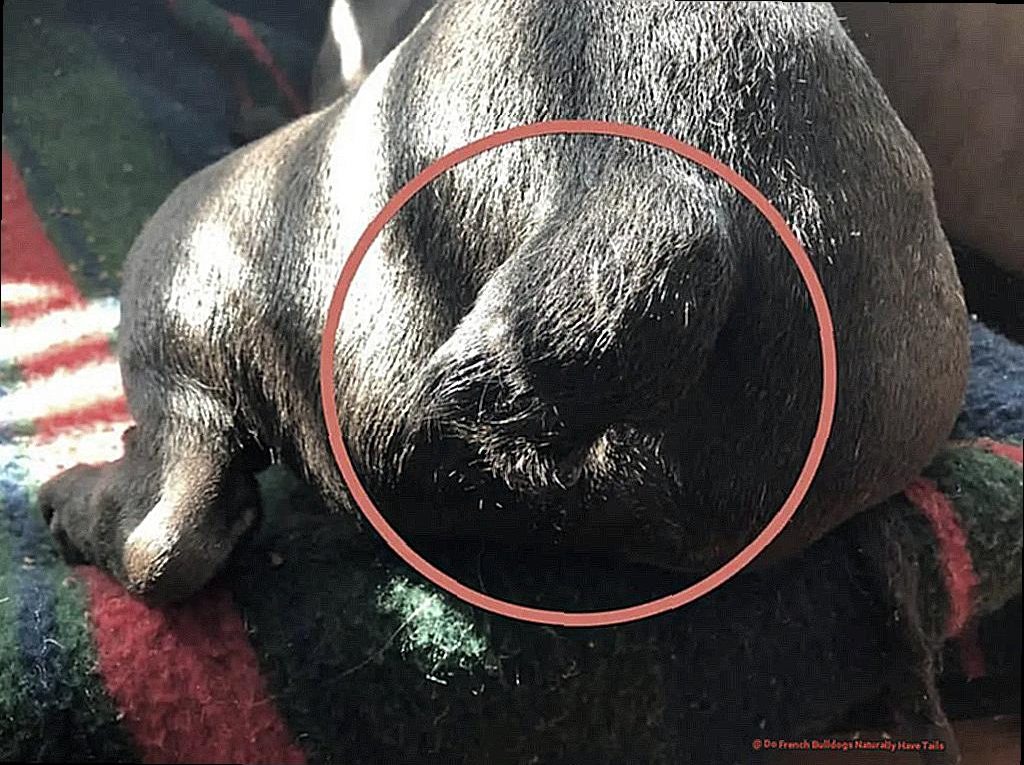Do French Bulldogs Naturally Have Tails?
Picture this: a small, stocky dog with an adorable flat face and bat-like ears.
You might think you have a clear image of a French bulldog in your mind, but there’s one important feature that often goes unnoticed – their tails. Unlike other breeds with long, wagging tails, Frenchies sport short and stumpy ones that seem to defy the laws of physics.
But why do these lovable pups have such unique tails? And what does it say about their breed?
So, kick back, relax, and let’s uncover the truth behind these cute little nubs together.
Do French Bulldogs Naturally Have Tails?
Contents
- 1 Do French Bulldogs Naturally Have Tails?
- 2 Understanding the “Screw Tail” Trait in French Bulldogs
- 3 Why Do French Bulldogs Have Short Tails?
- 4 Adaptations for Communication: How French Bulldogs Express Themselves Without Tails
- 5 Long-Tailed Frenchies: Genetic Variations and Crosses with Other Breeds
- 6 Caring for a French Bulldog’s Tail: What Owners Should Know
- 7 Debunking Myths About French Bulldogs and Their Tails
- 8 Conclusion
French bulldogs are beloved by many for their unique and charming appearance. From their squishy faces to their compact bodies, these adorable pups have captured the hearts of dog lovers all over the world. However, one aspect of this breed that often sparks confusion and controversy is their tail.
As an expert on French bulldogs, I am here to clear up any misconceptions and answer the burning question: do Frenchies naturally have tails? The short answer is no, but let’s dive deeper into this topic to gain a better understanding.
The Truth About French Bulldog Tails
Unlike most dog breeds, French bulldogs are born with a short, stumpy tail. This distinctive feature is often referred to as a “screw tail” due to its unique shape. While this tail may seem unnatural, it is actually a result of selective breeding over time.
The original ancestors of French bulldogs, English bulldogs, had longer and straighter tails. However, when they were bred with smaller breeds such as terriers and pugs, their tails became shorter and more curled. This was done to create a more compact and aesthetically pleasing dog breed.
Is it Ethical?
Some people may question the ethics behind selective breeding for physical characteristics such as tail length. However, it is worth noting that the screw tail in French bulldogs is not surgically altered but rather a natural result of breeding. This means that it is not harmful or painful for the dog.
Health Concerns
While the screw tail is a defining characteristic of French bulldogs, it can sometimes lead to health issues. Due to the shape and short length of their tails, these dogs are prone to spinal problems such as hemivertebrae. This condition can cause pain and mobility issues if not properly managed.
It is important for owners to be aware of this potential health concern and take preventative measures such as regular exercise and avoiding activities that put too much strain on their dog’s back.
The Tail-less Communicators
Some may wonder how French bulldogs communicate without the use of their tails. While it may seem like a disadvantage, these dogs have adapted to using other forms of communication, such as their expressive faces and body language. So don’t worry, your Frenchie will still be able to communicate with you and other dogs just fine.
What About Long-Tailed Frenchies?
Understanding the “Screw Tail” Trait in French Bulldogs
French bulldogs are a beloved breed known for their adorable bat ears and flat faces. But there is one physical feature that often raises questions among owners and potential owners – their tail. You may have heard that French bulldogs are born without tails, but the truth is a little more complicated. In this blog post, we will dive deeper into the “screw tail” trait in French bulldogs and its significance for their health.
The Genetics Behind the Screw Tail Trait
Unlike other breeds with a consistent tail appearance, French bulldogs can have a range of tail lengths and shapes. This is due to a genetic mutation known as the “screw tail” trait. This trait is a result of selective breeding, where dogs with shorter or absent tails were preferred for aesthetic purposes. Over time, this has led to a high percentage of French bulldogs being born with screw tails, which can range from a slight twist to a complete screw shape.
The Impact on Health
While the screw tail may seem like a harmless physical feature, it can actually cause health issues for French bulldogs. The short and tightly curled tails can lead to skin irritation, infections, and even spinal problems. As responsible owners, it is important to understand the potential health implications of this trait and take necessary precautions to ensure our pets’ well-being.
Not All French Bulldogs Have Screw Tails
It’s essential to note that not all French bulldogs are born with screw tails. Some may have longer, straight tails due to genetics or proper breeding practices. However, the majority of Frenchies do possess this trait, which often leads to confusion and misinformation about their natural tail appearance.
Proper Care for Your Frenchie’s Tail
As owners, it is our responsibility to educate ourselves about the screw tail trait in French bulldogs and take proper care of our furry friends. This includes regular grooming and check-ups with a veterinarian to monitor any potential health issues related to their tail. It’s also important to be gentle when handling their tails and avoid pulling or tugging on them.
Why Do French Bulldogs Have Short Tails?
Let’s take a closer look at the historical and evolutionary reasons behind this distinctive trait.
French bulldogs were originally bred in the 1800s from a mix of English bulldogs and smaller terriers. These dogs were used for ratting and bull-baiting, where having a short tail was advantageous. In bull-baiting, a popular blood sport at the time, dogs with shorter tails were less likely to be injured by the bull’s horns.
As bull-baiting became illegal, French bulldogs were no longer bred for this purpose. However, their short tails remained as a trait from their original ancestors. Some experts also believe that the shorter tail may provide better balance for the breed’s stocky body and prevent injuries while playing or running.
Another theory suggests that French bulldogs were selectively bred for their shorter tails for aesthetic purposes. In the 19th century, shorter tails were seen as more fashionable and desirable in dogs. This trend may have led to the breeding of dogs with shorter tails to achieve a certain look or head shape in the breed.
It is also possible that the breed’s short tails are a result of genetic mutation or natural selection. French bulldog puppies with longer tails may have been prone to injury or health issues, leading to the breeding of dogs with shorter tails.
Despite the various theories, one thing is certain – French bulldogs are now known for their short tails, which sets them apart from other dog breeds. However, it is important to note that not all Frenchies have extremely short tails. Some may have slightly longer tails due to genetic variation or mixed breeding.
In recent years, there has been a concerning trend of tail docking in French bulldogs for aesthetic purposes. However, this practice is illegal in many countries and is considered unethical by animal welfare organizations. It is vital to prioritize the health and well-being of these dogs over their physical appearance.
Adaptations for Communication: How French Bulldogs Express Themselves Without Tails
If you’re a proud owner of a French bulldog, you probably already know that they are known for their expressive faces. But did you know that they also have ways of communicating without their tails? That’s right, despite not having a tail, these lovable dogs are still able to effectively express themselves to their owners and other dogs. In this blog post, we’ll explore how French bulldogs adapt for communication without tails and how you can better understand your furry friend’s emotions and needs.
Posture Speaks Volumes
One of the main ways French bulldogs communicate without tails is through their posture. Just like humans, dogs can communicate a lot through body language. When feeling nervous or threatened, Frenchies may become stiff or tense. On the other hand, when they are excited, they may wag their hips or wiggle their entire body. Paying attention to your dog’s posture can give you insight into how they are feeling and help you respond accordingly.
The Many Faces of Frenchies
French bulldogs have a wide range of facial expressions that can convey different emotions. From happy to concerned to curious, these expressive dogs always seem to have something to say with their faces. So the next time your Frenchie gives you a certain look, pay attention as it may be trying to tell you something.
Ears Up or Ears Down?
Just like other breeds, French bulldogs use their ears to communicate as well. When they are alert or interested in something, their ears will stand up and point forward. However, if they are feeling nervous or submissive, their ears may be flattened against their head. Understanding what your Frenchie’s ears are telling you can help you better understand its mood and needs.
Vocalizations Galore
Frenchies are known for their distinct range of vocalizations. From barks to whines to grunts to snorts, these dogs have a unique way of communicating through their sounds. Different vocalizations can convey different messages, so it’s important to pay attention and learn your Frenchie’s language.

Long-Tailed Frenchies: Genetic Variations and Crosses with Other Breeds
French bulldogs, or “Frenchies,” are known for their signature short, stumpy tails that wag with unbridled enthusiasm. However, there is a small percentage of Frenchies that are born with longer tails, which can be caused by genetic variations or crosses with other breeds. As an expert on the topic of long-tailed Frenchies, I will delve into the potential causes of this genetic variation and how it can impact the breed standard and overall health of these lovable dogs.
Genetic Variations and the “Long-Tailed Gene”
The standard for French bulldogs set by the American Kennel Club (AKC) states that the tail should be “short, hung low, thick root and fine tip.” This means that a long tail on a Frenchie would not meet the breed standard and could potentially disqualify them from showing in AKC events. But what causes this deviation from the norm?
The answer lies in a recessive gene known as the “long-tailed gene” or the “rat-tail gene.” This genetic variation is responsible for long tails in French bulldogs and can also cause other physical differences, such as longer legs, a longer snout, and larger ears. It is important to note that this gene must be inherited from both parents to be expressed in their offspring, so responsible breeding practices are crucial in preventing its prevalence.
Crosses with Other Breeds
In addition to genetic variations, another possible cause of long-tailed Frenchies is crosses with other breeds such as Boston Terriers or Pugs. These breeds have similar physical characteristics to Frenchies and have been known to be crossed with them in the past. While this may result in puppies with longer tails than the breed standard, it is essential to consider the implications of mixing different breeds.
While long-tailed Frenchies may not meet the breed standard, they are still beloved by many owners. In fact, some even prefer the look of a longer tail on their Frenchie. However, it is important to note that these dogs may face health issues related to their genetic variations or crosses with other breeds. Therefore, it is crucial to do proper research and find a reputable breeder who can provide information on the genetic history of their dogs.
Caring for a French Bulldog’s Tail: What Owners Should Know
Are you the proud owner of a French bulldog? These lovable pups are known for their adorable appearance and playful personalities. But when it comes to caring for their tails, there are some important factors to consider.
Tail or No Tail?
One common question many owners have is whether or not French bulldogs have a naturally occurring tail. The answer is not as simple as a yes or no. While the standard for this breed is a short, “screw” or “corkscrew” shaped tail, there are rare cases where they may be born with a longer, straight tail. However, due to potential health issues, breeders have made it a standard practice to dock the tails of long-tailed French bulldogs at a young age.
Why Checking and Cleaning Matters
Regardless of the length of your French bulldog’s tail, it is important to regularly check and clean around the tail area. The folds and wrinkles around their tail can easily trap dirt and bacteria, leading to infections if not properly cleaned. Grooming your dog’s tail area should be a regular part of their grooming routine to prevent any potential health issues.
Be Mindful During Playtime
French bulldogs are active and love to play, but their natural short and curly tails make them more prone to injuries such as “tail pull” or “tail sprain”. This occurs when the tail is pulled too hard or bent in an unnatural direction, causing pain and discomfort for the dog. To prevent these types of injuries, it is important to be gentle and avoid tugging on their tail during playtime.
Rare Cases and Conditions
In some rare cases, French bulldogs may develop a condition known as “hemivertebrae”, where one or more vertebrae in the tail are malformed. This can cause the tail to appear twisted or kinked and may require medical attention. Regular check-ups with your veterinarian can help catch any potential issues early on.
Debunking Myths About French Bulldogs and Their Tails
French bulldogs are known for their adorable and unique appearance, from their bat-like ears to their compact bodies. However, there are many misconceptions surrounding their tails that often lead to confusion among owners. As an expert on French bulldogs and their tails, let’s debunk some of these common myths and provide accurate information for all French bulldog owners out there.
Myth #1: French Bulldogs Are Born Without Tails
One of the most common myths about French bulldogs is that they are born without tails. This is not true. Like all dogs, French bulldogs are born with a tail, but it may be shorter or more compact compared to other breeds. The tail of a French bulldog is often referred to as a “screw tail” because of its twisted appearance, which is due to their genetic makeup and breeding history.
Myth #2: Docking Is Necessary for Their Health
Many people believe that docking a French bulldog’s tail is necessary for their health. This is simply not true. Docking a dog’s tail involves removing a portion of the tail, which can cause pain and discomfort for the dog. It also serves no real purpose for their health or well-being. In fact, docking can have negative impacts on a dog’s communication with other dogs, as the tail is an important way for them to express emotions and communicate through body language.
Myth #3: French Bulldogs with Longer Tails Are Not Purebred
Some people may assume that a French bulldog with a longer tail is not a purebred or has been mixed with another breed. However, this is not always the case. Just like humans, dogs can have natural variations in their genetics, which can result in longer tails for some Frenchies. It’s important for owners to understand that tail length does not determine the purity of a French bulldog or affect their overall health and well-being.
Myth #4: Docking Does Not Hurt the Dog
Contrary to popular belief, docking a dog’s tail does cause pain and discomfort. The tail is an extension of the spine, and removing a portion of it can cause nerve damage and other complications. It is considered an inhumane and unnecessary practice by many animal welfare organizations, leading to stricter regulations and laws against it in many countries.
Also Read: Australian Bulldog Vs English Bulldog
Conclusion
In conclusion, French bulldogs are a cherished breed known for their lovable personalities and distinctive physical features, including their adorable tails.
While there may be misconceptions surrounding their tails, it is important to understand the truth behind this unique trait. Contrary to popular belief, Frenchies do have tails, but they may vary in length due to genetics and breeding practices.
It is crucial for responsible owners to educate themselves on proper care for their furry companions, including regular grooming of the tail area.




